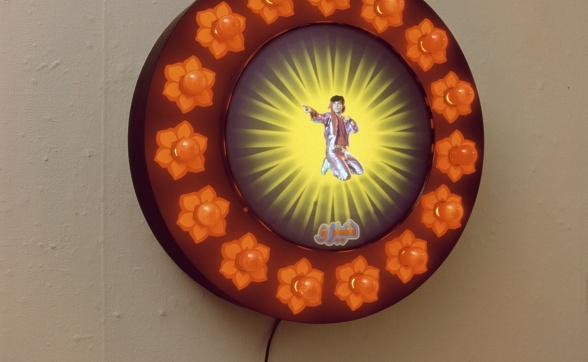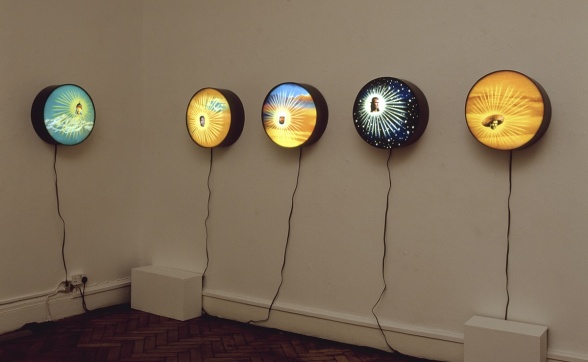Iftikhar Dadi and Elizabeth Dadi

Iftikhar and Elizabeth Dadi, Clash of Civilization (installation view), 2002

Iftikhar and Elizabeth Dadi, Jan Rambo (installation view)

Iftikhar and Elizabeth Dadi, They Made History (installation view), 1999-2001
Iftikhar and Elizabeth Dadi, Clash of Civilization (installation view), 2002
Iftikhar Dadi and Elizabeth Dadi (b. Pakistan/USA) work collaboratively from their New York base, employing imagery that draws heavily from global media, advertising, and the visual culture of South Asia. Their work transcends the specific context of its production to comment on the construction of national, ethnic and religious identities, the manipulation of historical narratives, the ever-present legacies of colonialism and contemporary cultural imperialisms. Global electronic media in particular, with its capacity to commodify every aspect of culture, provides the Dadis with potent reference points and a universally recognisable visual language.
In an increasingly fragile and intolerant world, whose citizens the Dadis see as ‘incestuously involved in carnivalesque power play in which both state power and mass response are theatrically enacted in cannibalistic consumption’, they have responded with work that is playful and irreverent, and its content – like the mass media they critique – has the power to both seduce and appal at the same time.
Popular iconography is interrogated in Clash of Civilizations (2002), a series of large digital images that parody cinema billboards. The series took its title from Samuel Huntington’s controversial thesis of an irreconcilable and enduring conflict between the West and other civilizations, especially the world of Islam.
The presence of Muslims in Europe has been seen as a ‘private nightmare’ of every European, evoking historical memories of ‘Saracen raiders in Western Europe and Turks at the gates of Vienna.’ This ‘West and the Rest’ distinction has been reinforced in the wake of the events of September 11, but it was already a deeply entrenched trope in popular American cinema. The Dadis exploited this ideologically-charged imagery to highlight the absurdity of these simplistic and reductive formulations.
The Dadis’ fascination with Hollywood’s rewriting of history and the influence of such cinematic readings on the public’s perception of great political figures and events was reflected in They Made History, a series of light-boxes, each displaying a computer-manipulated portrait of a historically significant non-western character. The faces of Geronimo, Zapata, Gandhi, Malcolm X, Genghis Khan, the Empress of China, the Mahdi of Sudan and the King of Siam – set against appropriately transcendent backgrounds of sunsets, cascading waterfalls, snow-capped mountains and infinite space – illuminated the world with rays of visionary light. Closer inspection, however, revealed a charade: it is the image of Denzel Washington – not the real Malcolm X – that glowed before us; the King of Siam turns out to be Yul Brynner in The King and I; and there’s Ben Kingsley as Gandhi, Chuck Connors as Geronimo and John Wayne’s Genghis Khan.
Suggesting that ‘it is impossible to think of great personalities without being haunted by filmic narratives – the events of history are recuperated most effectively in the imagery of the electronic media’, the Dadis played on our inability to differentiate fact from fiction. They contested the way the media frames trivialise the past and, in actively appropriating these popular western representations, they recuperated suppressed histories and suggested alternative readings.
Iftikhar Dadi and Elizabeth Dadi at Liverpool Biennial 2002
They Made History, 1999-2001
8 inkjet prints in circular back lit frames
Exhibited at the Bluecoat Gallery
Jan Rambo,
Inkjet print in circular back lit frame surrounded by 15 bulbs
Courtesy of artists
Exhibited at the Bluecoat Gallery
Clash of Civilization, 2002
Series of billboard installations
Courtesy of artists
Exhibited at Tate Liverpool and Bluecoat Gallery
Liverpool Biennial
55 New Bird Street
Liverpool L1 0BW
- T +44 (0)151 709 7444
- info@biennial.com
Liverpool Biennial is funded by
Founding Supporter
James Moores